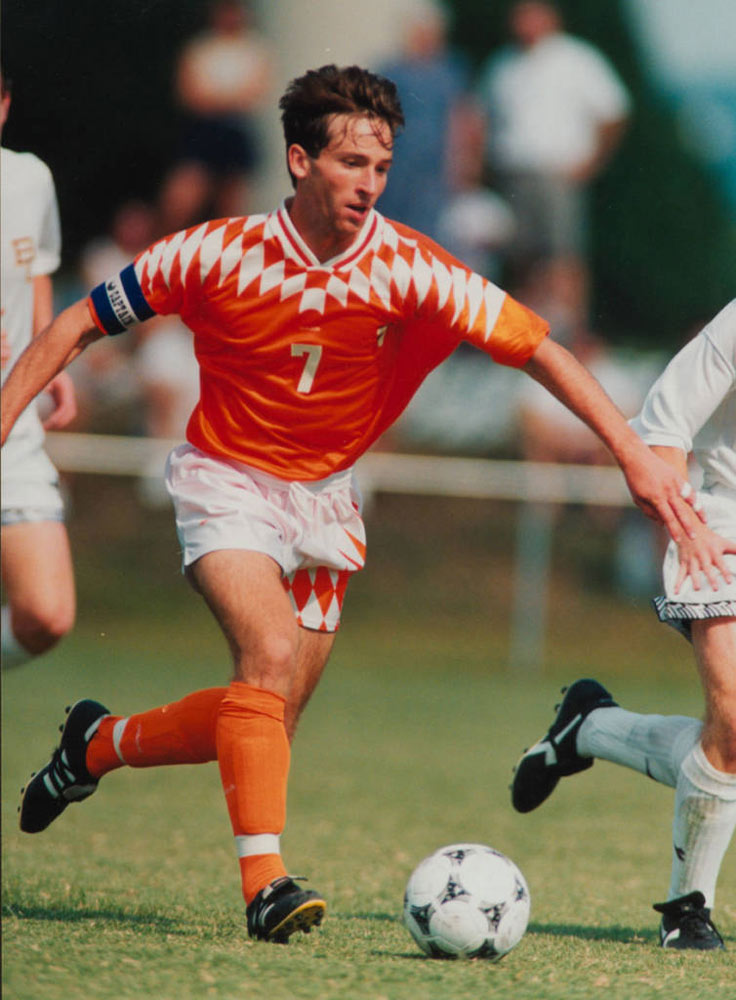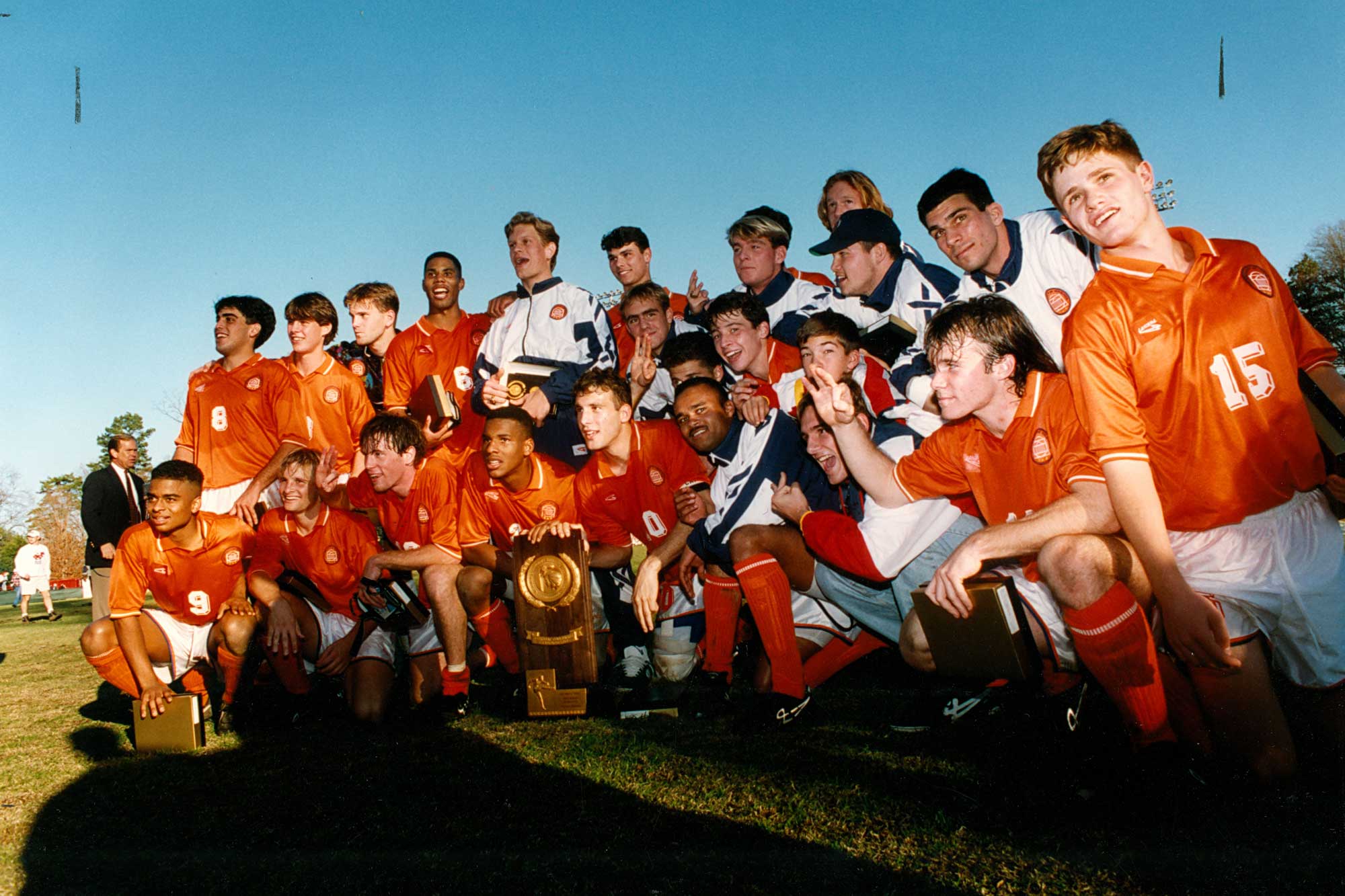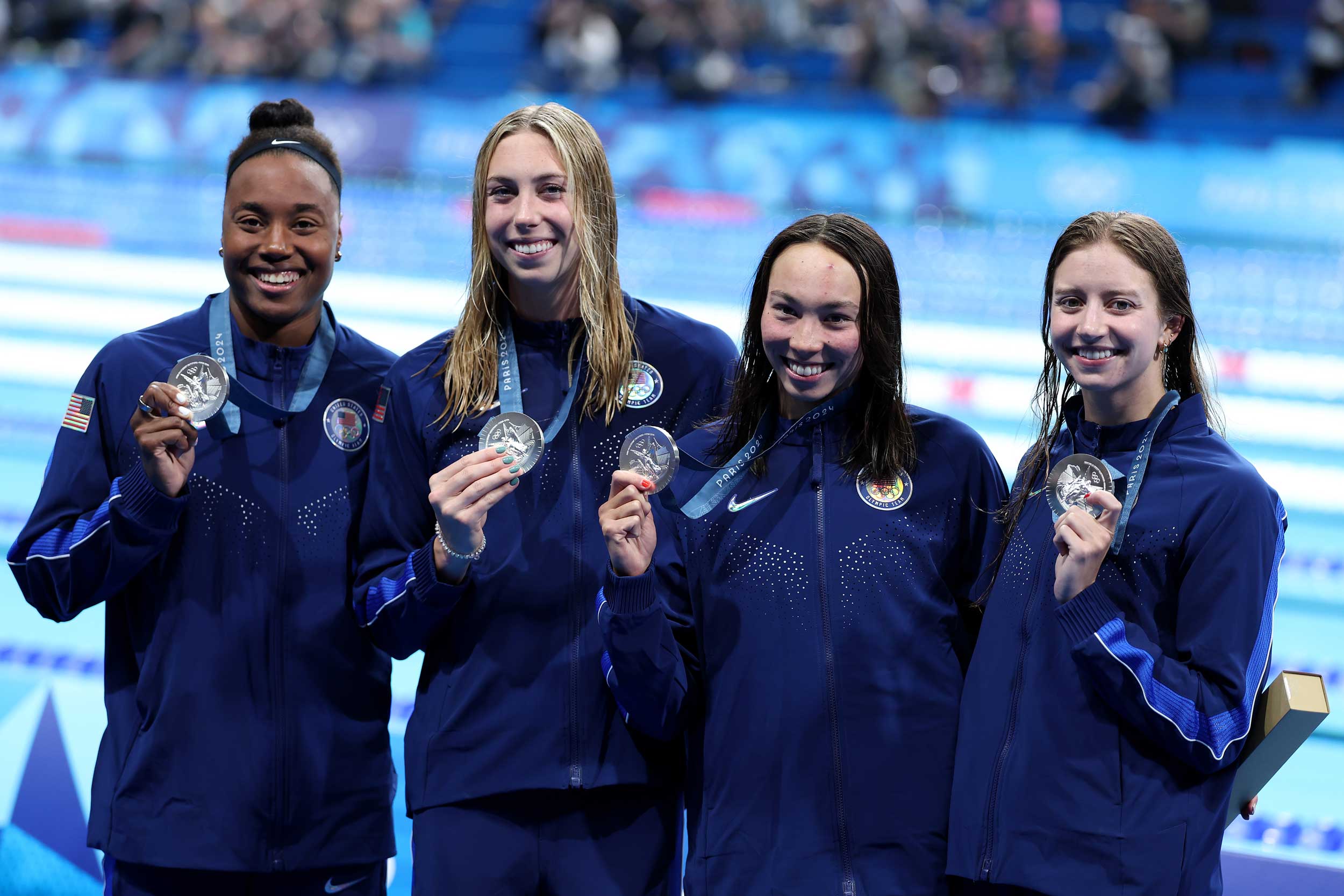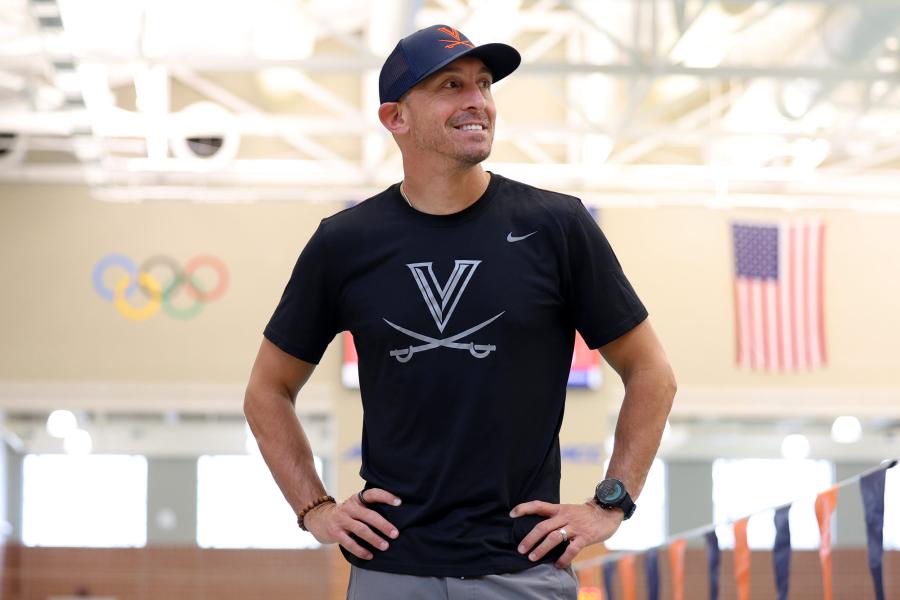Three decades later and now familiar with the origins of some of the players he was watching during past World Cups, Todd DeSorbo has a clearer assessment of the University of Virginia men’s soccer teams of the early 1990s.
“Man,” DeSorbo said, “they were loaded!”
DeSorbo, the architect of the UVA women’s swimming and diving powerhouse, has a trained eye for elite talent. He sees it every day at the Aquatic and Fitness Center, where the Cavaliers boast All-Americans and Olympians.
Bruce Arena used a similar recipe 30-plus years ago, turning the Wahoo men’s soccer program into a juggernaut.
For now, the two programs stand together as the only UVA varsity sports ever to win four consecutive national titles. That changes this week in Federal Way, Washington, should DeSorbo’s top-ranked Hoos conquer the NCAA championship meet a fifth straight time.
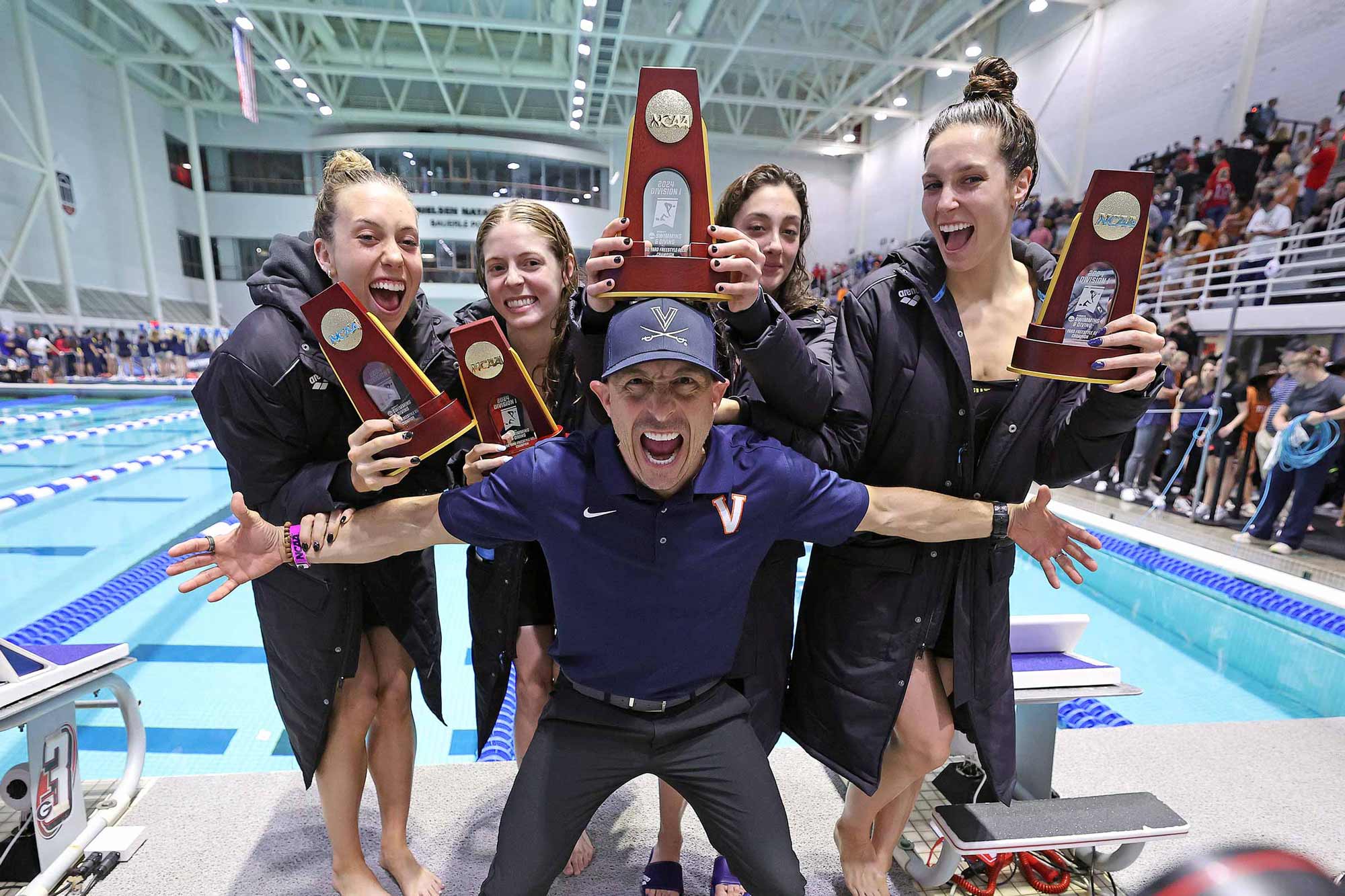
UVA swimming and diving head coach Todd DeSorbo is the architect of the nation’s most dominant program. (Photo by Matt Riley, University Communications)
From one dynasty to another, there’s mutual respect and admiration.
DeSorbo, who played his last soccer game as a high school senior in 1994, remembers following the sport’s national team then. What he didn’t realize until later was that several U.S. players – at least two on the four World Cup squads from 1990 to 2002; at least three on the three Olympic teams from 1992 to 2000 – were UVA products. And Arena, like DeSorbo last summer, was the U.S. coach for parts of that era.
The men’s soccer “four-peat” went from 1991 to 1994, a period before the advent of Major League Soccer in America where top players typically stayed in college for most, if not all, of their NCAA eligibility. Even future National Soccer Hall of Fame inductee Claudio Reyna spent three seasons with the Hoos – earning an All-America honor and a national title in all three – before turning pro.
[Presidential Libraries, Master Tape #01794]
[Drop by National Soccer Champions Event, February 23, 1994]
[Please Credit: Courtesy: William J. Clinton Presidential Library]
President Bill Clinton:
Please be seated.
A.J. Wood, University of Virginia soccer captain:
Good afternoon, Mr. Vice President, Mr. President.
My name is A.J. Wood, and I am a tri-captain of the University of Virginia men’s soccer team. Let me assure you that my public speaking class I am taking right now has done nothing to prepare me for something like this.
However, on behalf of the University of Virginia; our athletic director, Mr. Jim Copeland; our soccer coach, Mr. Bruce Arena; all of our players, and those that have come out today to help support us, we would like to extend our sincere gratitude and thanks to you for allowing us to come visit the White House today.
From a soccer perspective, from a player’s perspective, this is perhaps the greatest honor that we could achieve. And I am sure that it will rank up there as one of the most amazing days that we will ever have the rest of our lives.
Before we get to our gifts, we would like to give you, Mr. Vice President and Mr. President, a little exhibition of perhaps some of the things that got us to where we are today. So, Damien Silvera and Mike Fisher are going to show you a little bit of juggling.
[Sounds of players juggling a soccer ball, cameras clicking and audience laughing. Applause follows]
Besides this presentation, we also have a few gifts that we would like to bestow on you today. We know that both of you are involved in keeping physically fit, so we brought a few athletic things that you might be seen wearing while you jog through Washington, D.C.
We would like to present you with two jerseys.
President Clinton:
It’s a beautiful color.
Vice President Al Gore:
It’s great.
[Applause]
Wood:
And ladies and gentlemen, let me introduce the Vice President.
Vice President Gore:
Thank you very much.
[Applause]
Vice President Gore:
Very thoughtful of you to choose University of Tennessee colors on this.
[Laughter and jeers from the audience.]
Vice President Gore:
I’m off to a bad start!
[Laughter]
Vice President Gore:
Let me say a word of congratulations before I present the President to you. And I speak as the parent of a soccer goalie, and I know a little bit about this game. And watching my son play goalie with two players on the opposing team coming at him is even harder than going on the “David Letterman Show,” I’ll tell you!
[Laughter]
But it’s great to see the popularity of this wonderful sport. Three of our four children have played it. And our daughter, Sarah, plays in a league in Arlington as well as for her school team. And Tipper and I have learned a great deal about it, and it really is amazing to me to see that this great team has won three times in a row. I think that’s just incredible. And it shows also the level of excellence that is being attained in soccer in the United States. Several years ago, somebody asked – somebody who was not an American – asked how many years it took to produce an American soccer star. He said, “Five – that’s how long the naturalization takes.”
[Laughter]
Well, that’s not true anymore. Not only are you the best college team ever, I noticed from your roster you have 10 players from Virginia and two more from Maryland. A “foreigner” means being from New York or Tennessee.
This is a tremendous change and Senator Chuck Robb, who is a great supporter of the University of Virginia, has been bragging on you guys for some time. I also want to acknowledge Mrs. Landra Reid, wife of Senator Harry Reid, who is also here. And welcome Coach Bruce Arena, and Jim Copeland, the captains, and Damien and Mike, who gave that wonderful exhibition.
This is a sport that is going to explode in popularity. It is just on the cusp right now of becoming a major wave in American sports, and it is a great honor to be able to congratulate you here today.
And for that purpose, let me present to you now the President of the United States – and another soccer parent – President Bill Clinton.
[Applause as President Bill Clinton takes the podium]
President Clinton:
Thank you very much.
[Applause]
Thank you. Thank you very much, Mr. Vice President, Senator Robb, Mrs. Reid, and to the captains, and all the members of this wonderful team, and your coach, and your athletic director, and your parents and friends.
We are very honored to have you here today.
I was thinking about this a little bit. The Vice President is right that – he and I are from the South, and when we were boys, nobody played soccer down there. We had to learn about it really through our children.
One of my most prized pictures is a picture of my daughter trying to do what they did. It hangs on my wall in the White House – now with Chelsea kicking her soccer ball.
I have followed this game closely since she was about 5 and entered a league that had both boys and girls in it. I watched the little girls grow up, in this league, fighting with the boys on the soccer field. It was a great experience for me.
I am really proud that the United States is going to host the World Cup here. I think it will do a lot for soccer in the United States and a lot for our image as a soccer-playing country throughout the world.
But I think that today I’d like to focus on what this fine team has done for this sport in the United States, and to thank you for that.
I also noticed that Coach, my researchers tell me that your record is 252-54, and 29 ties. If that is true, we would like to invite you to become a congressional liaison – we would like margins like that on our major bills.
[Laughter]
I don’t know how you did that.
[Laughter]
I was also thinking we might recruit your goaltender, Jeff Causey.
Where are you?
That’s what being President is like – people take shots at you all the time, day in, day out.
[Laughter]
We decided you could help us be in the right sort of frame of mind to come to work every day.
We’re delighted to have you here. We’re proud of you. We’re proud of what you represent, and proud of the teamwork you represent. And that’s the last point I’d like to make.
One of the things I really like about soccer is that, even though people are given the chance to star, to excel, to score it really is fundamentally a team sport.
It’s a sport where people really have to think about what’s best for the team and how they can do well together.
And that’s a lesson we’re trying to get across to America now. There are a lot of economic, and educational, and social problems that we can only face if we start to think of each other again, as well as ourselves and start to play on a team again.
And so, you have set a good example – not only for soccer – but for the way we might do better in our own lives.
And we thank you for that and wish you well.
Congratulations!
[Applause]
“It’s really impressive,” said DeSorbo, who came to UVA from North Carolina State University in 2017. “I mean, in swimming, there’s a lot you can control that you probably can’t in a team sport like soccer. For us, if one of our swimmers is a little bit off, somebody else can probably make it up and it’s not going to have that much impact (on the score). But if your star forward is a little bit off, and not scoring, you’re done.
“So, to manage egos, to manage high-level athletes, to manage injuries and health and all that four years in a row, it’s really impressive.”
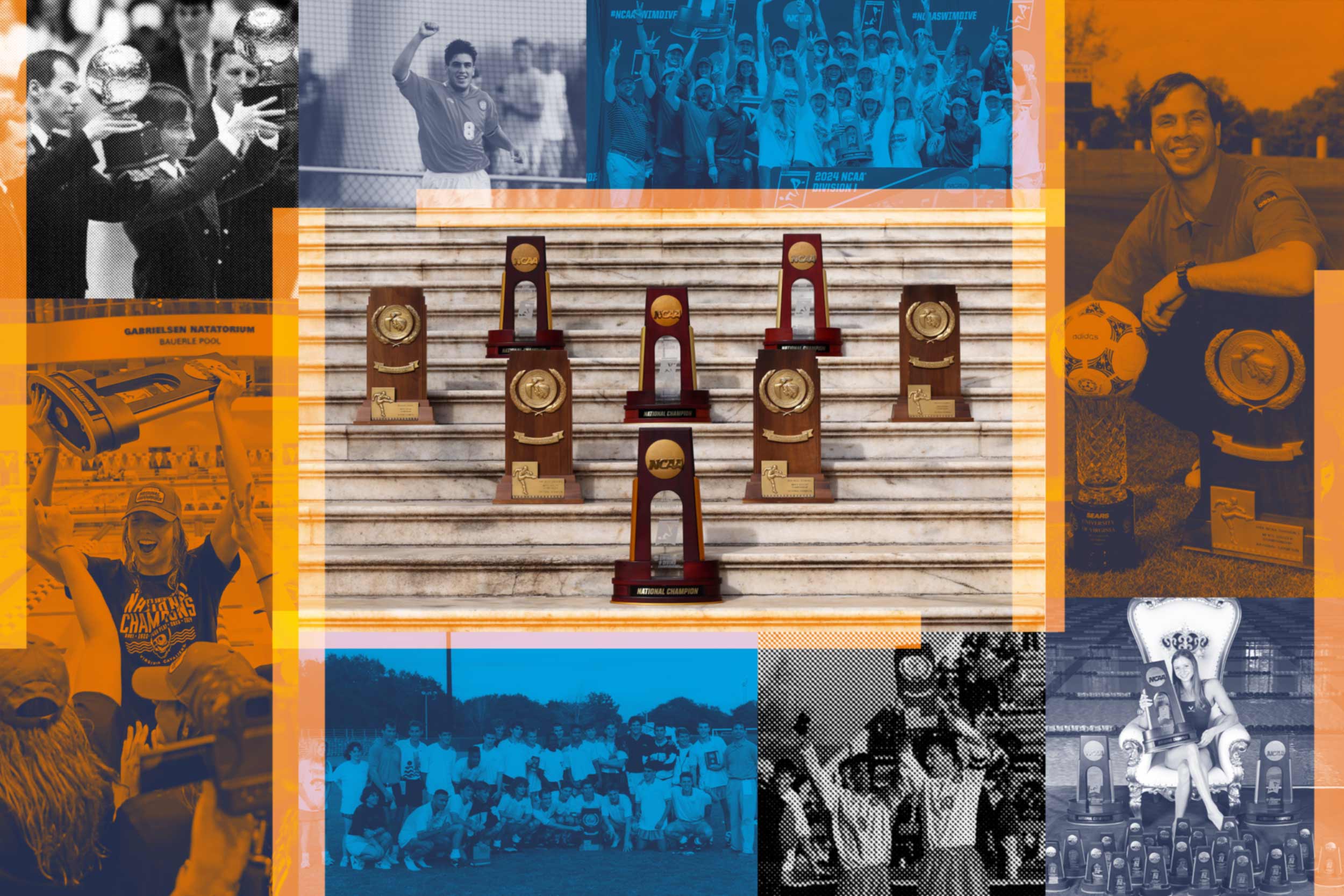

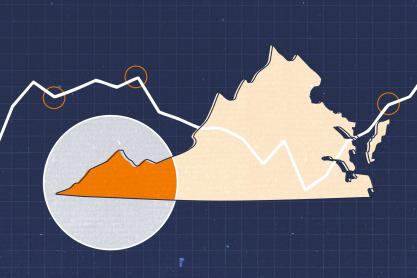
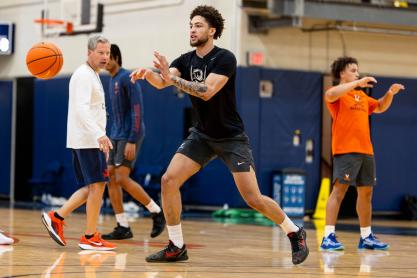
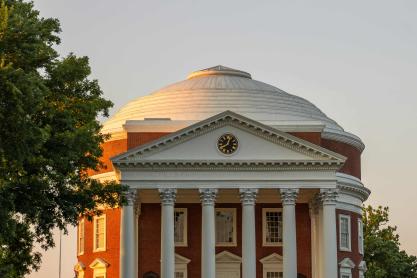

.jpg)
